|
Art movements |
Minimalism |
Conceptual art |
Public reactions |
Art world reactions |
Artists
Artists
 |
|
|
|
|
|
|
|
 |
Carl Andre
A sculptor and poet, Andre was one of the leading artists associated with Minimalism. Although initially carving and using wood and Perspex to create abstract geometric sculptures, from the mid 1960s he began to use simple blocks of repeated material to create the sculptures for which he is best known.
My arrangements I've found are essentially the simplest I can arrive at, given a material and a place... the one thing I learned in my work is that to make the work I wanted you couldn't impose properties on the materials. You have to reveal the properties of the material
Carl Andre as quoted in Tate Liverpool Minimalism catalogue, 1978
His sculpture Equivalent VIII made up of bricks arranged in a geometric formation caused great controversy when exhibited at Tate in the late 1970s. Andre was a close friend of Barbara Reise. As well as writing about his work, her archive includes many informal letters and postcards from the artist. |
|

Private view card for John Baldessari exhibition, Nova Scotia College of Art & Design (detail)
© John Baldessari |
 |
John Baldessari
Although initially a painter, Baldessari began to question the medium and by the mid- 1960s was using texts and photography alongside paint on canvas. In the 1970s he rejected painting altogether in favour of printmaking, film, video, installation, sculpture and photography. His work investigates the complexity of language drawing on popular culture and humour.
Reise was in close contact with Baldessari and liaised with him about a book-work Studio International were planning to publish. In 1974, Baldessari gave Barbara a piece of art:
THANK YOU FOR MY-VERY-OWN-PIECE! It's lovely!... I puzzled and puzzled over the smoke/ashtray relation - 'til the penny dropped into the airbrush...and I "understood...partly". And yet I keep wondering and love it! Am planning the "right" wall...
Letter from Barbara Reise to John Baldessari, 18 May 1974 |
|

Private view card for Daniel Buren exhibition, The Hang Up, Los Angeles (detail)
© Daniel Buren |
 |
Daniel Buren (b. 1938, France)
A French conceptual artist who uses painting to question the status of the medium and of art more generally. From 1965, he began to create paintings of alternate coloured and white vertical stripes. Since the late 1960s his work has been site specific, often located in various non-gallery spaces, with the installation of the work responding to the nature of the space or location.
Reise planned to include work by Buren in a lecture series about contemporary art she was putting together for a company called 'Art Information Distribution'. In a letter dated 13 September 1974, she describes his:
"radical" activity inside/outside institutional art-world politics |
|

Letter from James Lee Byars to Barbara Reise.
© Courtesy the estate of James Lee Byars and Michael Werner Gallery |
 |
James Lee Byars (1932-97, USA)
An internationally renowned artist whose work was characterised by his involvement in many disciplines. Byars spent ten years in Japan, studying art, philosophy and language. The Zen philosophy he practised during that time was to have a great influence on his work. A sculptor, performance and installation artist, Byars was noted for his idiosyncratic letters sent to friends and supporters, such as this tissue paper purple love heart sent to Barbara Reise.
In another letter, this time written on pink tissue, Byars writes:
"Dear Barbara, I thank you for the intros. MayB over the next few months I can vis[it] London ... What are you doing for Winter? ... what do you read? How does Eng[land] grow? Love Byars. |
|
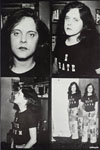
Private view card for COUM Transmissions
© Cosey Fanni Tutti & Genesis P-Orridge.
Photo credit Cosey Fanni Tutti |
 |
COUM
aka Genesis P-Orridge, b. 1950, UK and Cosey Fanni Tutti, b. 1950, UK)
COUM Transmissions (COUM for short) were a radical performance group comprising Genesis P-Orridge and Cosey Fanni Tutti. COUM's work was shocking and often explicit which, combined with Cosey Fanny Tutti's interest in pornography (she was herself a model), provoked outrage from the right-wing media. In 1975 COUM were taken to court by the Post Office, when postcards featuring nudes in provocative positions were posted to various people by P-Orridge. Barbara Reise was one of those called on to defend COUM in the court room, and noted in his defence:
I was very impressed by his maturity and sincerity as an artist, despite his youth (he is ten years younger than I am) and wanted to know more about what he did ... So much so that I made a special trip to Paris to document and witness his performances and activities there in September at a personal financial expense and trouble which is unusual form; so much so that I plan to PRESENT HIS WORK as a special feature in the FIRST issue (and dummy) for the new magazine on which I'm investing my whole reputation as a critic. |
|
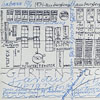
Note / diary entry from Hanne Darboven to Barbara Reise (detail)
© Hanne Darboven |
 |
Hanne Darboven (b. 1941, Germany)
A German conceptual artist, Darborven moved to New York in 1965 and began to make drawings based on mathematical calculations. From the late 1960s the calendar schema formed the basis for her art. In the 1970s she devised her own written pattern-based language which she used to transcribe sections of text by writers such as Jean-Paul Sartre and Heinrich Heine.
Reise was greatly supportive of Darboven. In 1975 the artist had her first solo show at Castelli Gallery, but had to leave New York soon afterwards. Reise writes warmly (and with humour) to sympathise with the artist in a letter dated 20 Dec 1975:
My feeling for your work and frustration at having to leave NYC after your 1st Castelli show was the direct cause of my finishing the psychoanalytic treatment I was getting in London - though it took some months to do it properly |
|
|
 |
Jan Dibbets (b. 1941 Netherlands)
Initially a minimalist painter, Dibbets began to experiment with what he called 'Perspective Corrections' from about 1967. In these works he placed geometric forms in the landscape and studio, which he then photographed in such a way as to render different shapes entirely and to confuse the viewer's sense of perspective. Dibbets also worked with film, and more recently with acrylic and watercolour alongside photography.
Reise wrote the catalogue essay for Dibbets' British Council exhibition in Bristol in 1976-7. She describes his work as:
Grounded in the pictorial aesthetics and the concerns about mankind-versus-nature of ...art history... Dibbets also uses essential properties of the "new" photographic medium in a creative and comfortable way not depending on its "novelty" or commercially exploited effects for his art |
|

Braco Dimitrijevic, artist book, Interview
© Braco Dimitrijevic |
 |
Braco Dimitrijevic (b. 1948, Yugoslavia)
A conceptual artist whose work in the 1970s dealt with the problem of lack of communication in contemporary society, Dimitrijevic moved to London in 1971. Typical of his work was the placement of busts and portraits of unknown people in public places, such as the street interventions Casual Passer-by I Met... where he placed photo portraits on the city streets. In 1976 he published the theoretical text Tryptichos Post Historicos. In March 1971, Dimitrjevic wrote - apologising for his poor English - to Barbara:
Long time ago it was not possible to send anything to England ... For Christmas we were in Sarajevo where we bought these slippers for you. They are hand-made by Bosnian country man. We hope these slippers will make your feet hot ... Love from Braco and Nena. |
|
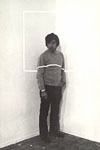
Benni Efrat postcard, Make an Eye a Hand
© Benni Efrat |
 |
Benni Efrat (b.1935 Lebanon)
An Israeli artist who settled in London in 1966, and later moved to the USA. Primarily a sculptor and film maker, he was concerned during the 1960s and 1970s, with movement, and the flow of time and energy. He also explored the relationships between object and space, using light and shadows to define matter, in works such as August, from the Undercover Blues Series (1980).
Barbara Reise corresponded with Efrat and he asked her to write about his work.
I like art which poses problems for everyone else but doesn't set out to solve them; art whose implications outstrip one's comprehension at any one point in its confrontation...I like art whose context is (or wants to be) the whole history of art and not just the styles and sales of the last decade. I don't like a lot of "art". But I very much like the art of Benni Efrat
'Benni Efrat: New Work', Barbara Reise, Studio International, September 1969 |
|
|
 |
Dan Flavin (1933-1996, USA)
A self-taught artist, Flavin began his career as a painter. In his early work of the late 1950s and early 1960s he incorporated objects into his paintings. By 1961, he had made a number of minimalist works using fluorescent electric lights mounted on monochrome square panels. He soon abandoned the square mounts that anchored the lights, and by 1964 was making installations, usually temporary, for particular spaces using both white and coloured lights.
There is extensive correspondence between Flavin and Reise in her archive. These letters include discussion of his art (Reise was commissioned to write a book about Flavin for the publishers Penguin); and the wider art world. Reise greatly admired Flavin as a thinker as well as an artist. In February 1969 she wrote to him:
The more I try to come to grips with your work the more I am awed. Re-reading your writings only increases this. No wonder people don't write about you any more - you stupefy them into silence if they have any common sense |
|

Letter from Hamish Fulton to Barbara Reise
© Hamish Fulton |
 |
Hamish Fulton (b. 1946, UK)
A photographer and conceptual artist, whose work since 1968 has centred on the act of walking through landscape. He uses photographs and text to document the walks which are often presented in book form. The documentation ranges from mundane details such as length of walk and weather conditions, to the poetic 'mood' inspired by a particular walk.
Reise planned to write about Fulton's work in an article for L'Art Vivant about 'good thought provoking art in Britain now', and in January 1972 wrote to the artist asking for an interview:
I've been interested in what I've seen of your work...and would very much like to see and understand more... Would you consider helping me to catch up on what you've done so I can write with accuracy rather than ignorant enthusiasm? |
|

Art & Project Bulletin 20: Gilbert & George: 'George by Gilbert'; 'Gilbert by George'
© Gilbert & George |
 |
Gilbert and George (b. 1943 / 1942)
British sculptors Gilbert Proesch and George Passmore met in 1967 at St Martin's School of Art in London. They rejected the approaches to sculpture taught at St Martin's as elitist and removed from the real world and instead made themselves into sculpture, so that everyday human actions could be considered as art. They sacrificed their separate identities and dispensed with their surnames to become Gilbert and George - a living sculpture. Although working in a variety of mediums, including photography, performance, and 'mail art', they refer to all their work as sculpture. Using themselves as subject matter, they explore their own experiences of life. Ordinary experiences such as getting drunk become art, recorded in works such as Balls or the evening before the Morning after (1972).
Reise planned to write about Fulton's work in an article for L'Art Vivant about 'good thought provoking art in Britain now', and in January 1972 wrote to the artist asking for an interview:
They are an amazing experience with all the reality and unreality of a dream... Feelings brought out by Gilbert & George relate to Life/Death, Joy/Mourning, youthful-insouciance/jaded-experience, mystery/clarity, boredom/fascination... universal and timeless art
She ends the article with the words:
Everything I've said is what I like about Gilbert & George; but what I like best is that I still don't know where they're at or where they'll go, yet they make me smile and carry on wondering. |
|
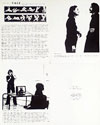
Dan Graham poster, Video/Performance Works..., John Gibson Gallery, New York
Courtesy Lisson Gallery & the Artist |
 |
Dan Graham (b. 1942, USA)
In 1964 Graham founded a gallery in New York. This put him into contact with Minimalist artists such as André, LeWitt and Judd. His role within the gallery world led him to question the existing structures of the art-world and the way work was displayed. He began to make art himself that existed without recognized art systems and from 1965 to 1969 produced works that were published in magazines. In the 1970s Graham worked primarily with performance and video, exploring the notion of public and private space and individual / group relationships. Such experiments led to his involvement with architectural projects, from 1976 onwards.
That Reise respected Graham a great deal can be seen in the letter she wrote to him in April 1975, asking him to put in a good word for her at the California Institute of Arts where she had applied for a teaching position. She tells Graham: 'There are few friends, fewer artists' whom she would ask to undertake such a role.
Graham replied with the words: 'I...would recommend you in terms so good you wouldn't believe', providing us with a glimpse of the respect that Reise as a critic and friend inspired.
They are an amazing experience with all the reality and unreality of a dream... Feelings brought out by Gilbert & George relate to Life/Death, Joy/Mourning, youthful-insouciance/jaded-experience, mystery/clarity, boredom/fascination... universal and timeless art |
|
|
 |
Hans Haacke (b. 1936, Germany)
In the 1960s Haacke's work explored natural phenomena and ecological systems. He developed analytical models for such investigations which he later applied to his methodical critique of the political and economic structures underlying the art world and society more widely.
In 1971 The Guggenheim Museum in New York cancelled an exhibition of Haacke's work.
His proposal had been to present two works based on an investigation into the real estate holdings of two Manhattan companies, but the Guggenheim felt that his reference to specific individuals was inappropriate and was also worried about the legal implications of exhibiting the work. Reise wrote an article supporting Haacke's position for Studio International.
The whole history of the Haacke exhibition becomes important as a sort of model for the infinitely varied particular problems encountered in art-museum exhibitions of 'avant-garde art'. Ignorance of these potential problems is no longer respectable, and responsibility for coping with them - somehow - must be shared by any artists and institutions which agree to participate
'A Tail of Two Exhibitions: The aborted Haacke and Robert Morris Shows', Studio International, July/August 1971 |
|

Susan Hiller, artist book Dedicated to the Unknown Artists (detail)
© Susan Hiller |
 |
Susan Hiller (b. 1945, USA)
A conceptual artist, writer and curator, Hiller moved to London in 1967. Since the early 1970s she has worked in a variety of media including painting, sculpture, video, printed texts, photography and installation. In her work she questions the traditional artistic concerns of authorship, subject matter and approaches to art-making, applying her social, feminist and anthropological interests to her investigations.
Her explorations include cultural processes of classification, such as in Dedicated to the Unknown Artists (1972-6), an installation of 305 postcards showing coastal views of rough seas presented alongside charts and notes documenting the difference between the visual representation of the 'rough seas' and the written descriptions of them. |
|
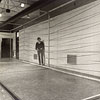
John Hilliard photographed with one of his installations
© John Hilliard |
 |
John Hilliard (b. 1945, UK)
Initially a sculptor and installation artist, in the late 1960s Hilliard turned primarily to photography. In his work he investigated how the manipulation of visual images can affect our understanding of what we see around us. In the mid 1970s he began to address social issues through photography, particularly those relating to age, race and gender, creating works inspired by billboard advertising and the cinema.
A lively exchange of letters between Reise and Hilliard in March 1974, reflects the often frank discussions that Reise had with the artists she wrote about. She suggests that she and Hilliard 'have a very basic disagreement' about aesthetics. |
|
|
 |
Douglas Huebler (b. 1924, USA)
One of the pioneers of conceptual art, from the 1960s Huebler used photography and text to state the existence of people and things in terms of time and place. Many of his pieces are self-portraits documenting personal activities, and the work often has an humorous as well as humane vein to it. One of the works he is perhaps best known for was the project he set himself in 1971 to 'photographically document, to the extent of his capacity, the existence of everyone alive'.
On seeing an exhibition of Huebler's work in Düseldorf, Reise wrote to the artist:
I really liked your show: especially in the way that the ideas/notices worked with the gallery space - making it not pointless that they were where they were. I took slides (irony compounded on irony) of all the notices and the graphite marks |
|
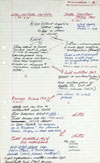
Notes by Barbara Reise about Minimalism as Style Label
© Tate Archive, 2003 |
 |
Donald Judd (1928-1994)
Judd's art school training included art theory as well as painting and sculpture, and for the rest of his career his writings formed an important part of his output. He began as a painter, but his paintings developed first into low reliefs and then, in the early 1960s, to freestanding works. Between 1964 and 1966 Judd perfected his formal vocabulary which was labelled 'Minimalism' because of the honed down nature of the work. The sculpture, made up of precise geometrical forms, were a logical extension from colourfield painting. The floor pieces were innovative in that he dispensed with the plinth, on which sculpture was normally displayed, and placed the works directly on the floor - thus questioning the status of the art object.
Barbara Reise edited a special issue of Studio International on 'Minimalist' art. Her essay: Untitled 1969: a footnote on art and minimalist stylehood discussed the work of Judd, alongside that of André, Flavin, and LeWitt. She says of the artists:
All NYC, all know each other, with respect. All highly articulate, involved with ideas not just object-making |
|
|
 |
Joseph Kosuth (b. 1945, USA)
A key artist and theorist associated with the conceptual art movement. From 1965 he began to create works using objects, photographs and texts that explored the relationship between linguistic definitions and the objects they referred to. In the later 1960s he dispensed with objects entirely and presented instead enlarged dictionary definitions of words. He later explored non-gallery settings for his work using billboards and the advertisement sections of magazines. |
|
|
 |
Sol LeWitt (b. 1928, USA)
LeWitt began to paint while working as a graphic designer in the mid 1950s. In 1962 he abandoned painting, instead creating minimal structures and reliefs. He made his first wall drawing in 1968, after having experimented with modular and serial floor and wall constructions from the mid 1960s. LeWitt, like other Minimalist and conceptual artists emphasised the idea behind the artwork over execution. As each work was planned in advance, an assistant could make the work as easily as the artist. Although the formal qualities of the work; the simple geometric shapes and structures, and the use of basic units, link his work to the Minimalist aesthetic, he considered himself a conceptual artist. In fact, he can be seen as bridging the gap between the two movements.
Reise wrote about LeWitt's work in her article 'Untitled 1969: a footnote on art and minimalist stylehood', Studio International, 1969. In an essay on LeWitt's use of colour written in July 1970, she says of the artist's work:
If one were to look for some standard with which to compare LeWitt as an artist, the inventor of Esperante would be more relevant than the author of Ulysses. For it is the grammar of colour rather than its heartbeat immediacy in grand or ant-heroic humanity which LeWitt has used to go out on a limb over the abyss of irrelevance |
|

Richard Long, A Sculpture by Richard Long Presented by Konrad Fischer (detail)
© Richard Long |
 |
Richard Long (b. 1942, UK)
Photographs, maps and text are used by Long to document his art, which centres on the activity of walking. In his early work, Long often made temporary interventions with the landscape but in his more recent work, natural materials from the landscape are removed and installed in gallery spaces.
Following the arrangement of a meeting Barbara sent Long a telegram on 22 July 1972, as there appeared to be a misunderstanding:
Received your letter and don't understand reference to unintended formal interview STOP Am incapable of making such with artist I respect STOP ... I apologise and will wait till the cows come home. Yours Barbara'. |
|
|
 |
Robert Morris (b. 1931, USA)
As well as making a series of Duchamp-inspired conceptual sculpture that investigated the role of language in artistic depiction in the early 1960s, Morris was a central figure in experimental dance theatre in New York. In the mid to late 1960s he played an important role in shaping the objectives of Minimalism. Using ephemeral materials such as dirt, felt and mirrors, he created a series of sculptures over the next ten years that aimed to de-materialize the art object.
Morris's short-lived exhibition at the Tate Gallery in 1971, in which he invited visitors to the exhibition to interact with the sculptures on display, provoked a huge media debate about modern art. Reise defended the artist in her article for Studio International, 'A tail of two exhibitions: the aborted Haacke and Robert Morris shows'. |
|
|
 |
Barnett Newman (1905-1970, USA)
Although not a Minimalist or Conceptual artist, Barnett Newman is included here because of his close relationship with Barbara Reise, who viewed him as a father figure.
Newman painted in the 1930s in an American Expressionist style, but stopped painting around c.1939-40. In 1944-5 he began to make work again creating a series of swiftly-executed drawings of organic subjects such as seeds and plant growth in chalks and oil crayon. In 1948 he began to paint canvases using a single colour interrupted by one or more vertical stripes, and in 1949 produced his first large wall-size paintings. He continued to make large scale monochrome paintings into the 1960s, and from 1965 began to make steel sculptures alongside the paintings. His first one-man exhibition was held at the Betty Parsons Gallery, New York, in 1950.
For me and many others, Barnet Newman establishes a prickly presence of that something which has to do with essence of being an artist and a human being...the scope of his stance is such that no simplistic verbal categories fit... He is the modern Renaissance Man Old Master: accepting categories respected through human history, but always re-examining and re-making them within and through his own contributions
Barbara Reise, 'The stance of Barnett Newman', Studio International, February 1970, pp.49-63 |
|

Ed Ruscha, artist book, Royal Road Test
© Ed Ruscha |
 |
Ed Ruscha (b. 1937, USA)
Ruscha is often associated with Pop Art, but although he included popular imagery in his work, his impetus was very different from other Pop artists. Rather than making art about other art, Ruscha explored the relationships between word and image in his work. Such explorations, and more specifically the books of deadpan photographs he published, such as Twenty-six Gasoline Stations, link him with the aims and interests of conceptual art. |
|
|
 |
Lawrence Weiner (b. 1942, USA)
A conceptual artist who had no formal art training, but achieved international recognition for a series of text-based works that explored the process of art making. In 1968 he made his first book, Statements, which contained twenty-four brief descriptions of works; some of which had not been actually made. From this time language was central to Weiner's practice and books, wall-texts, posters, graffiti and videotapes have all been used by the artist.
Reise was a close friend, and admired Weiner's work. In a letter to the artist written in January 1976, she writes:
The more I contemplate your own work the more I am committed of its importance for now and later...please believe, Larry, in the very ultimate importance I attach to "a high" given (as such) by this work-of-yours... |
|
